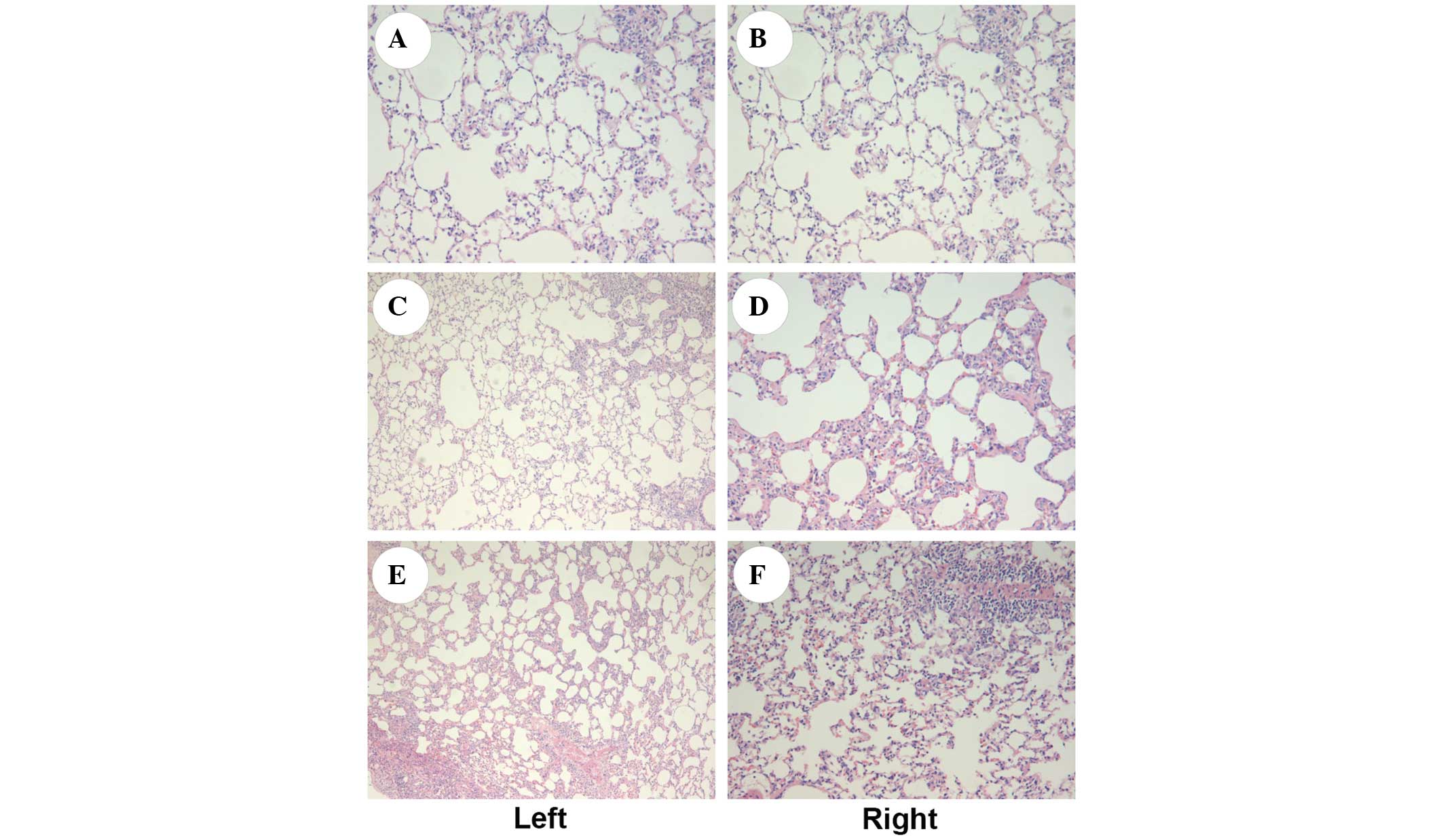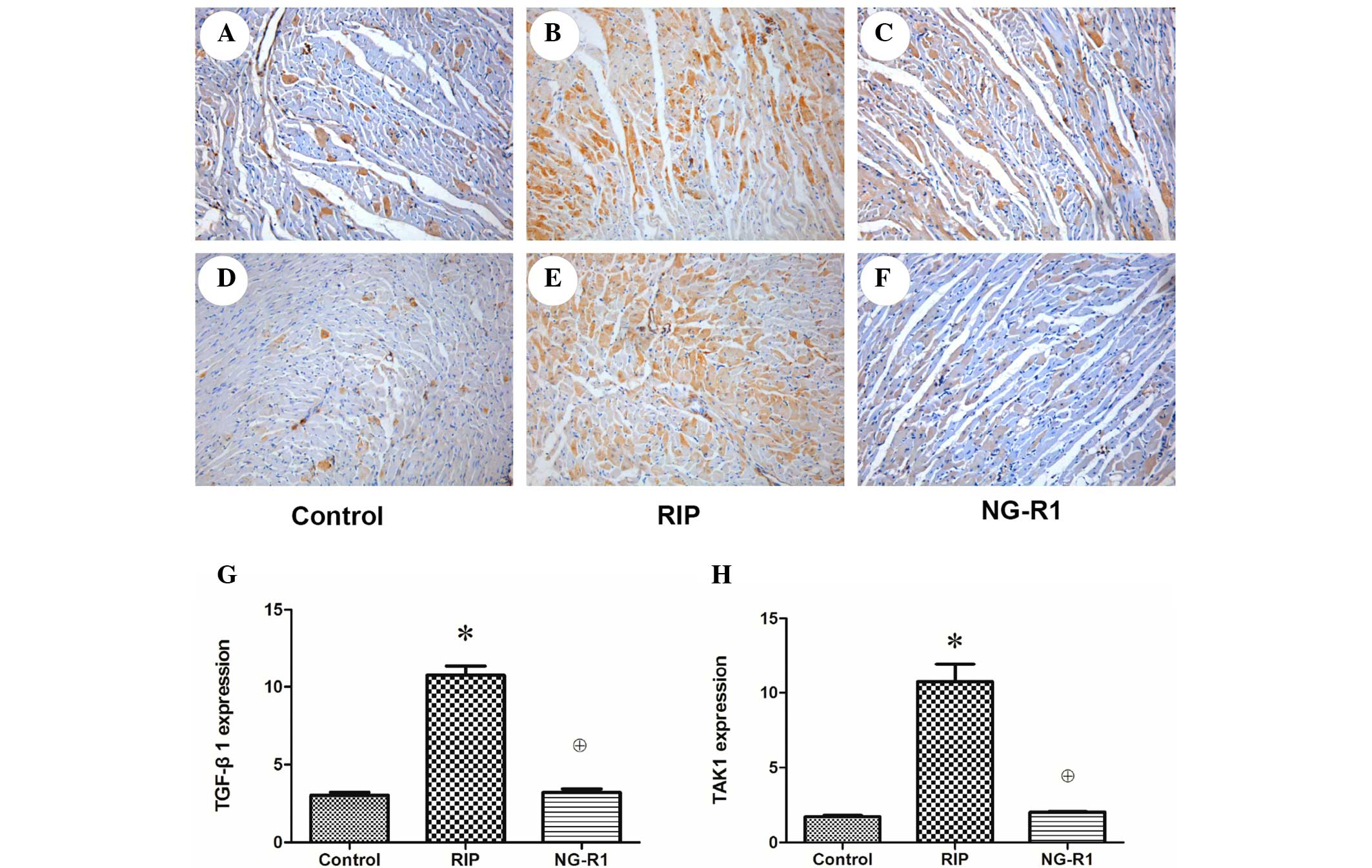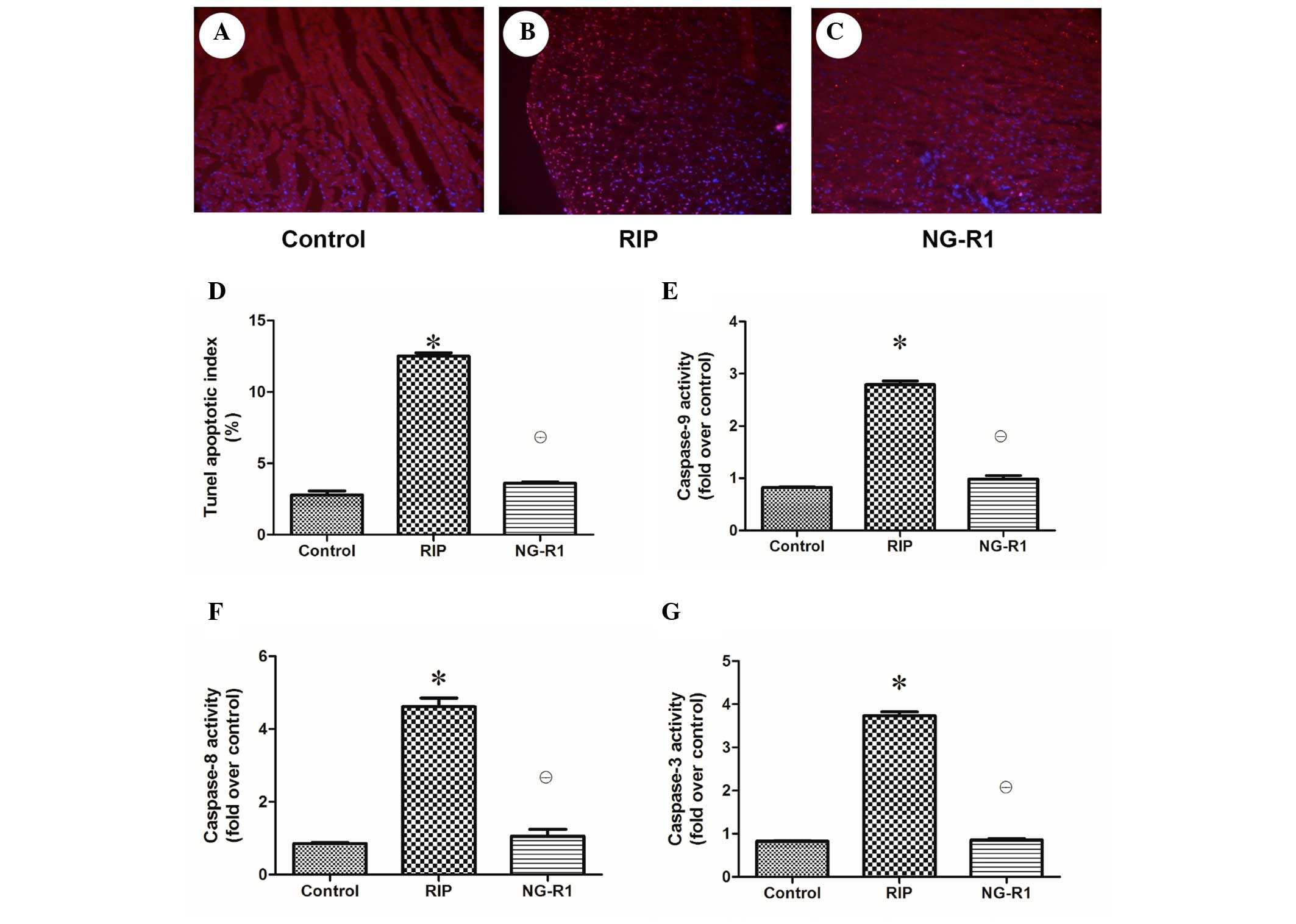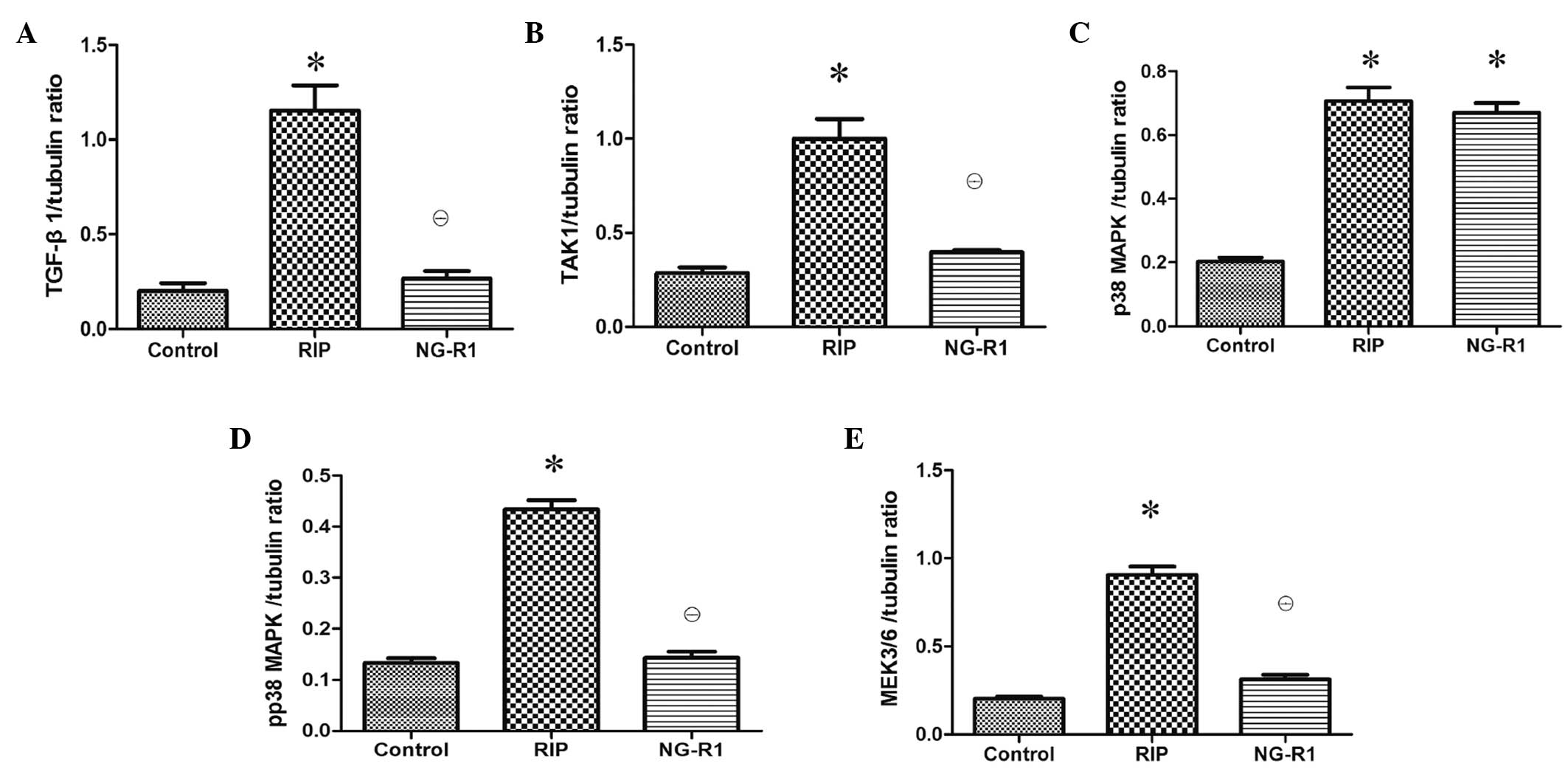|
1
|
Bell RM and Yellon DM: There is more to
life than revascularization: Therapeutic targeting of myocardial
ischemia/reperfusion injury. Cardiovasc Ther. 29:e67–e79. 2011.
View Article : Google Scholar : PubMed/NCBI
|
|
2
|
Smith CC and Yellon DM: Adipocytokines,
cardiovascular pathophysiology and myocardial protection. Pharmacol
Ther. 129:206–219. 2011. View Article : Google Scholar : PubMed/NCBI
|
|
3
|
Lecour S: Activation of the protective
survivor activating factor enhancement (SAFE) pathway against
reperfusion injury: Does it go beyond the RISK pathway? J Mol Cell
Cardiol. 47:32–40. 2009. View Article : Google Scholar : PubMed/NCBI
|
|
4
|
Matsumoto-Ida M, Takimoto Y, Aoyama T,
Akao M, Takeda T and Kita T: Activation of TGF-beta1-TAK1-p38 MAPK
pathway in spared cardiomyocytes is involved in left ventricular
remodeling after myocardial infarction in rats. Am J Physiol Heart
Circ Physiol. 290:H709–H715. 2006. View Article : Google Scholar : PubMed/NCBI
|
|
5
|
Vanlangenakker N, Van den Berghe T,
Bogaert P, Laukens B, Zobel K, Deshayes K, Vucic D, Fulda S,
Vandenabeele P and Bertrand MJ: cIAP1 and TAK1 protect cells from
TNF-induced necrosis by preventing RIP1/RIP3-dependent reactive
oxygen species production. Cell Death Differ. 18:656–665. 2011.
View Article : Google Scholar : PubMed/NCBI
|
|
6
|
Omori E, Morioka S, Matsumoto K and
Ninomiya-Tsuji J: TAK1 regulates reactive oxygen species and cell
death in keratinocytes, which is essential for skin integrity. J
Biol Chem. 283:26161–26168. 2008. View Article : Google Scholar : PubMed/NCBI
|
|
7
|
Blanco S, Santos C and Lazo PA:
Vaccinia-related kinase 2 modulates the stress response to hypoxia
mediated by TAK1. Mol Cell Biol. 27:7273–7283. 2007. View Article : Google Scholar : PubMed/NCBI
|
|
8
|
Kodym R, Kodym E and Story MD:
Sequence-specific activation of TAK1-D by short double-stranded
RNAs induces apoptosis in NCI-H460 cells. RNA. 14:535–542. 2008.
View Article : Google Scholar : PubMed/NCBI
|
|
9
|
Goodman MD, Koch SE, Fuller-Bicer GA and
Butler KL: Regulating RISK: A role for JAK-STAT signaling in
postconditioning? Am J Physiol Heart Circ Physiol. 295:H1649–H1656.
2008. View Article : Google Scholar : PubMed/NCBI
|
|
10
|
Boengler K, Buechert A, Heinen Y, Roeskes
C, Hilfiker-Kleiner D, Heusch G and Schulz R: Cardioprotection by
ischemic postconditioning is lost in aged and STAT3-deficient mice.
Circ Res. 102:131–135. 2008. View Article : Google Scholar : PubMed/NCBI
|
|
11
|
Wang YQ MS and Le MZ: The protective
effect of erythropoietin against myocardial ischemia-reperfusion
injury in rats. J Med Postgra. 37:668–671. 2005.
|
|
12
|
Lutgens E, Daemen MJ, de Muinck ED, Debets
J, Leenders P and Smits JF: Chronic myocardial infarction in the
mouse: Cardiac structural and functional changes. Cardiovasc Res.
41:586–593. 1999. View Article : Google Scholar : PubMed/NCBI
|
|
13
|
Dong TT, Cui XM, Song ZH, Zhao KJ, Ji ZN,
Lo CK and Tsim KW: Chemical assessment of roots of Panax
notoginseng in China: Regional and seasonal variations in its
active constituents. J Agric Food Chem. 51:4617–4623. 2003.
View Article : Google Scholar : PubMed/NCBI
|
|
14
|
Zhang HS and Wang SQ: Notoginsenoside R1
inhibits TNF-alpha-induced fibronectin production in smooth muscle
cells via the ROS/ERK pathway. Free Radic Biol Med. 40:1664–1674.
2006. View Article : Google Scholar : PubMed/NCBI
|
|
15
|
Zhang HS and Wang SQ: Notoginsenoside R1
from Panax notoginseng inhibits TNF-α-induced PAI-1 production in
human aortic smooth muscle cells. Vascul Pharmcaol. 44:224–230.
2006. View Article : Google Scholar
|
|
16
|
Grishin AV, Iavorovskiĭ AG, Zhidkov IL,
Charchian ÉR, Ivanova AG, Paliulina MV and Sitnichenko NV:
Sevoflurane optimal dosage estimation for myocardium
pharmacological postconditioning: An experimental study. Anesteziol
Reanimatol. 41–44. 2013.(In Russian). PubMed/NCBI
|
|
17
|
McGrath JC, Drummond GB, McLachlan EM,
Kilkenny C and Wainwright CL: Guidelines for reporting experiments
involving animals: The ARRIVE guidelines. Br J Pharmacol.
160:1573–1576. 2010. View Article : Google Scholar : PubMed/NCBI
|
|
18
|
Styer AK, Sullivan BT, Puder M, Arsenault
D, Petrozza JC, Serikawa T, Chang S, Hasan T, Gonzalez RR and Rueda
BR: Ablation of leptin signaling disrupts the establishment,
development and maintenance of endometriosis-like lesions in a
murine model. Endocrinology. 149:506–514. 2008. View Article : Google Scholar : PubMed/NCBI
|
|
19
|
Hajrezaie M, Hassandarvish P,
Moghadamtousi SZ, Gwaram NS, Golbabapour S, Najihussien A,
Almagrami AA, Zahedifard M, Rouhollahi E, Karimian H, et al:
Chemopreventive evaluation of a Schiff base derived copper (II)
complex against azoxymethane-induced colorectal cancer in rats.
PloS One. 9:e912462014. View Article : Google Scholar : PubMed/NCBI
|
|
20
|
Draper HH, Squires EJ, Mahmoodi H, Wu J,
Agarwal S and Hadley M: A comparative evaluation of thiobarbituric
acid methods for the determination of malondialdehyde in biological
materials. Free Radic Biol Med. 15:353–363. 1993. View Article : Google Scholar : PubMed/NCBI
|
|
21
|
Sun Y, Oberley LW and Li Y: A simple
method for clinical assay of superoxide dismutase. Clin Chem.
34:497–500. 1988.PubMed/NCBI
|
|
22
|
Narula J, Kolodgie FD and Virmani R:
Apoptosis and cardiomyopathy. Curr Opin Cardiol. 15:183–188. 2000.
View Article : Google Scholar : PubMed/NCBI
|
|
23
|
Zhang WJ, Wojta J and Binder BR:
Notoginsenoside R1 counteracts endotoxin-induced activation of
endothelial cells in vitro and endotoxin-induced lethality in mice
in vivo. Arterioscler Thromb Vasc Biol. 17:465–474. 1997.
View Article : Google Scholar : PubMed/NCBI
|
|
24
|
Liu WJ, Tang HT, Jia YT, Ma B, Fu JF, Wang
Y, Lv KY and Xia ZF: Notoginsenoside R1 attenuates renal
ischemia-reperfusion injury in rats. Shock. 34:314–320. 2010.
View Article : Google Scholar : PubMed/NCBI
|
|
25
|
Fadel E, Mazmanian GM, Chapelier A, Baudet
B, Detruit H, de Montpreville V, Libert JM, Wartski M, Herve P and
Dartevelle P: Lung reperfusion injury after chronic or acute
unilateral pulmonary artery occlusion. Am J Respir Crit Care Med.
157:1294–1300. 1998. View Article : Google Scholar : PubMed/NCBI
|
|
26
|
Horgan MJ, Lum H and Malik AB: Pulmonary
edema after pulmonary artery occlusion and reperfusion. Am Rev
Respir Dis. 140:1421–1428. 1989. View Article : Google Scholar : PubMed/NCBI
|
|
27
|
Wided K, Hassiba R and Mesbah L:
Polyphenolic fraction of Algerian propolis reverses doxorubicin
induced oxidative stress in liver cells and mitochondria. Pak J
Pharm Sci. 27:1891–1897. 2014.PubMed/NCBI
|
|
28
|
Chang G, Zhang D, Yu H, Zhang P, Wang Y,
Zheng A and Qin S: Cardioprotective effects of exenatide against
oxidative stress-induced injury. Int J Mol Med. 32:1011–1020.
2013.PubMed/NCBI
|
|
29
|
Freudlsperger C, Bian Y, Contag Wise S,
Burnett J, Coupar J, Yang X, Chen Z and Van Waes C: TGF-β and NF-κB
signal pathway cross-talk is mediated through TAK1 and SMAD7 in a
subset of head and neck cancers. Oncogene. 32:1549–1559. 2013.
View Article : Google Scholar : PubMed/NCBI
|
|
30
|
Arsura M, Panta GR, Bilyeu JD, Cavin LG,
Sovak MA, Oliver AA, Factor V, Heuchel R, Mercurio F, Thorgeirsson
SS and Sonenshein GE: Transient activation of NF-kappaB through a
TAK1/IKK kinase pathway by TGF-beta1 inhibits AP-1/SMAD signaling
and apoptosis: Implications in liver tumor formation. Oncogene.
22:412–425. 2003. View Article : Google Scholar : PubMed/NCBI
|
|
31
|
Li C, Qu X, Xu W, Qu N, Mei L, Liu Y, Wang
X, Yu X, Liu Z, Nie D, et al: Arsenic trioxide induces cardiac
fibroblast apoptosis in vitro and in vivo by up-regulating TGF-β1
expression. Toxicol Lett. 219:223–230. 2013. View Article : Google Scholar : PubMed/NCBI
|
|
32
|
Vivar R, Humeres C, Ayala P, Olmedo I,
Catalán M, García L, Lavandero S and Díaz-Araya G: TGF-β1 prevents
simulated ischemia/reperfusion-induced cardiac fibroblast apoptosis
by activation of both canonical and non-canonical signaling
pathways. Biochim Biophys Acta. 1832:754–762. 2013. View Article : Google Scholar : PubMed/NCBI
|
|
33
|
Chen Z, Shen X, Shen F, Zhong W, Wu H, Liu
S and Lai J: TAK1 activates AMPK-dependent cell death pathway in
hydrogen peroxide-treated cardiomyocytes, inhibited by heat shock
protein-70. Mol Cell Biochem. 377:35–44. 2013. View Article : Google Scholar : PubMed/NCBI
|
|
34
|
Freude B, Masters TN, Robicsek F, Fokin A,
Kostin S, Zimmermann R, Ullmann C, Lorenz-Meyer S and Schaper J:
Apoptosis is initiated by myocardial ischemia and executed during
reperfusion. J Mol Cell Cardiol. 32:197–208. 2000. View Article : Google Scholar : PubMed/NCBI
|
|
35
|
Tramontano AF, Muniyappa R, Black AD,
Blendea MC, Cohen I, Deng L, Sowers JR, Cutaia MV and El-Sherif N:
Erythropoietin protects cardiac myocytes from hypoxia-induced
apoptosis through an Akt-dependent pathway. Biochem Biophys Res
Commun. 308:990–994. 2003. View Article : Google Scholar : PubMed/NCBI
|
|
36
|
Guo X, Chen KH, Guo Y, Liao H, Tang J and
Xiao RP: Mitofusin 2 triggers vascular smooth muscle cell apoptosis
via mitochondrial death pathway. Circ Res. 101:1113–1122. 2007.
View Article : Google Scholar : PubMed/NCBI
|
|
37
|
Kim JK, Pedram A, Razandi M and Levin ER:
Estrogen prevents cardiomyocyte apoptosis through inhibition of
reactive oxygen species and differential regulation of p38 kinase
isoforms. J Biol Chem. 281:6760–6767. 2006. View Article : Google Scholar : PubMed/NCBI
|
|
38
|
Guo JW, Deng ZJ, Fu YH, Yang M, Ren B, Pan
JQ and Liu RX: Effects of Panax notoginsenoside on TNF-alpha and
MMP-2 expressions in rats with post-myocardial infarction
ventricular remodeling and the mechanism. Nan Fang Yi Ke Da Xue Xue
Bao. 29:2048–2050. 2009.(In Chinese). PubMed/NCBI
|



















